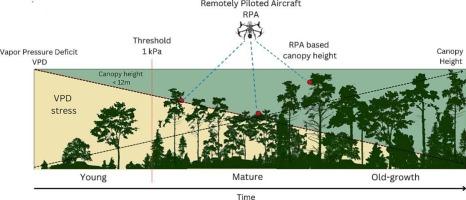Local atmospheric vapor pressure deficit as microclimate index to assess tropical rainforest riparian restoration success
IF 8
1区 环境科学与生态学
Q1 ENVIRONMENTAL SCIENCES
引用次数: 0
Abstract
Characterizing microclimatic variables, such as vapor pressure deficit (VPD), is crucial for monitoring ecological processes and biodiversity dynamics of forests, among other terrestrial ecosystems. Approaches using technologies such as remotely piloted aircraft (RPA) have demonstrated potential for assessing the biophysical interface between forests and the atmosphere by obtaining high-resolution microclimatic metrics in space and time. In the present study, we developed a microclimatic approach based on VPD modeling to quantify the success of forest restoration in a tropical rainforest landscape. We used the photogrammetric technique Structure from Motion (SfM) with RPA to estimate three-dimensional forest structures and evaluated its influence in obtaining metrics for VPD modeling. A total of 30 plots of 314 m2 were analyzed at five stages of riparian forest development, including areas of early-stage passive restoration (E10, 10 years and E14, 14 years), mid-stage natural forest regeneration (M26, 26 years and M29, 29 years), and an old-growth forest (REF). These plots were used to calibrate and validate the VPD model (∼70 % training data and ∼ 30 % test data, with k = 10). Old-growth forests exhibited an average VPD of 0.19 kPa, lower than younger forests that exceeded the 1.0 kPa threshold. The 50th and 75th percentiles of the height distribution explained 86 % and 83 % of the variance in VPD (RMSE of 0.34 kPa), respectively, and demonstrated the potential use of this metric to predict the effects of forest structure on VPD. Results show that early-stage restoration sites are exposed to higher threshold limits of VPD, which can affect ecosystem functioning. Spatial characterization allows for identifying target areas for interventions, increasing our capacity to support better decisions in forest management.

局地大气水汽压差作为评价热带雨林河岸恢复成功的小气候指标
表征微气候变量,如蒸汽压差(VPD),对于监测森林等陆地生态系统的生态过程和生物多样性动态至关重要。利用诸如遥控飞机(RPA)等技术的方法已显示出通过获得空间和时间上的高分辨率微气候指标来评估森林与大气之间生物物理界面的潜力。在本研究中,我们开发了一种基于VPD模型的小气候方法来量化热带雨林景观中森林恢复的成功程度。我们利用摄影测量技术SfM (Structure from Motion)和RPA对三维森林结构进行了估计,并评估了其对VPD建模指标的影响。研究区共30个样地,面积314 m2,分5个阶段,包括早期被动恢复区(E10、10年和E14、14年)、中期自然森林更新区(M26、26年和M29、29年)和原生林区(REF)。这些图用于校准和验证VPD模型(约70%的训练数据和约30%的测试数据,k = 10)。原生林的平均VPD为0.19 kPa,低于超过1.0 kPa阈值的年轻林。高度分布的第50百分位和第75百分位分别解释了VPD方差的86%和83% (RMSE为0.34 kPa),并证明了该指标用于预测森林结构对VPD的影响的潜力。结果表明,早期恢复点暴露于较高的VPD阈值,会影响生态系统功能;空间表征有助于确定干预措施的目标地区,提高我们支持更好的森林管理决策的能力。
本文章由计算机程序翻译,如有差异,请以英文原文为准。
求助全文
约1分钟内获得全文
求助全文
来源期刊

Science of the Total Environment
环境科学-环境科学
CiteScore
17.60
自引率
10.20%
发文量
8726
审稿时长
2.4 months
期刊介绍:
The Science of the Total Environment is an international journal dedicated to scientific research on the environment and its interaction with humanity. It covers a wide range of disciplines and seeks to publish innovative, hypothesis-driven, and impactful research that explores the entire environment, including the atmosphere, lithosphere, hydrosphere, biosphere, and anthroposphere.
The journal's updated Aims & Scope emphasizes the importance of interdisciplinary environmental research with broad impact. Priority is given to studies that advance fundamental understanding and explore the interconnectedness of multiple environmental spheres. Field studies are preferred, while laboratory experiments must demonstrate significant methodological advancements or mechanistic insights with direct relevance to the environment.
 求助内容:
求助内容: 应助结果提醒方式:
应助结果提醒方式:


